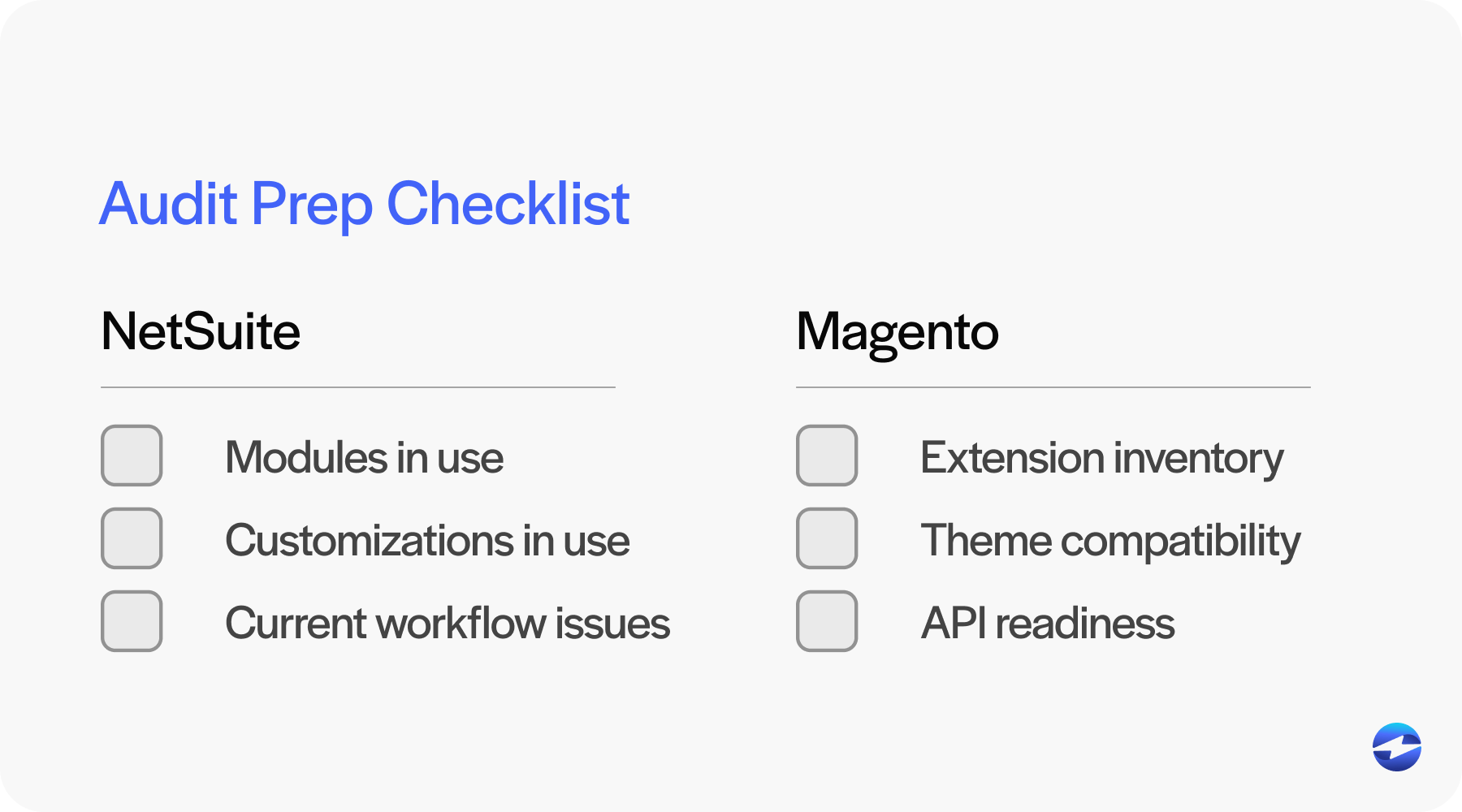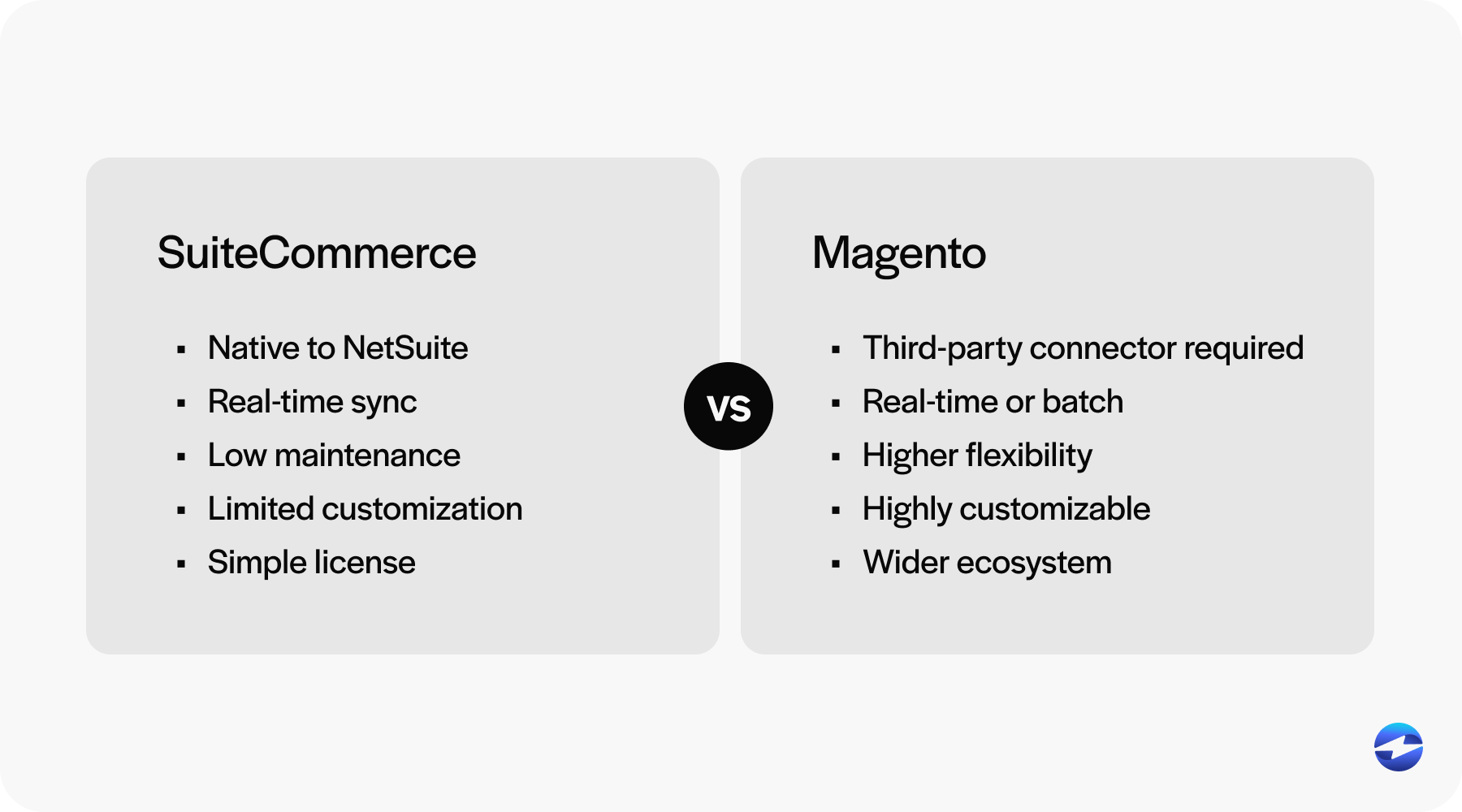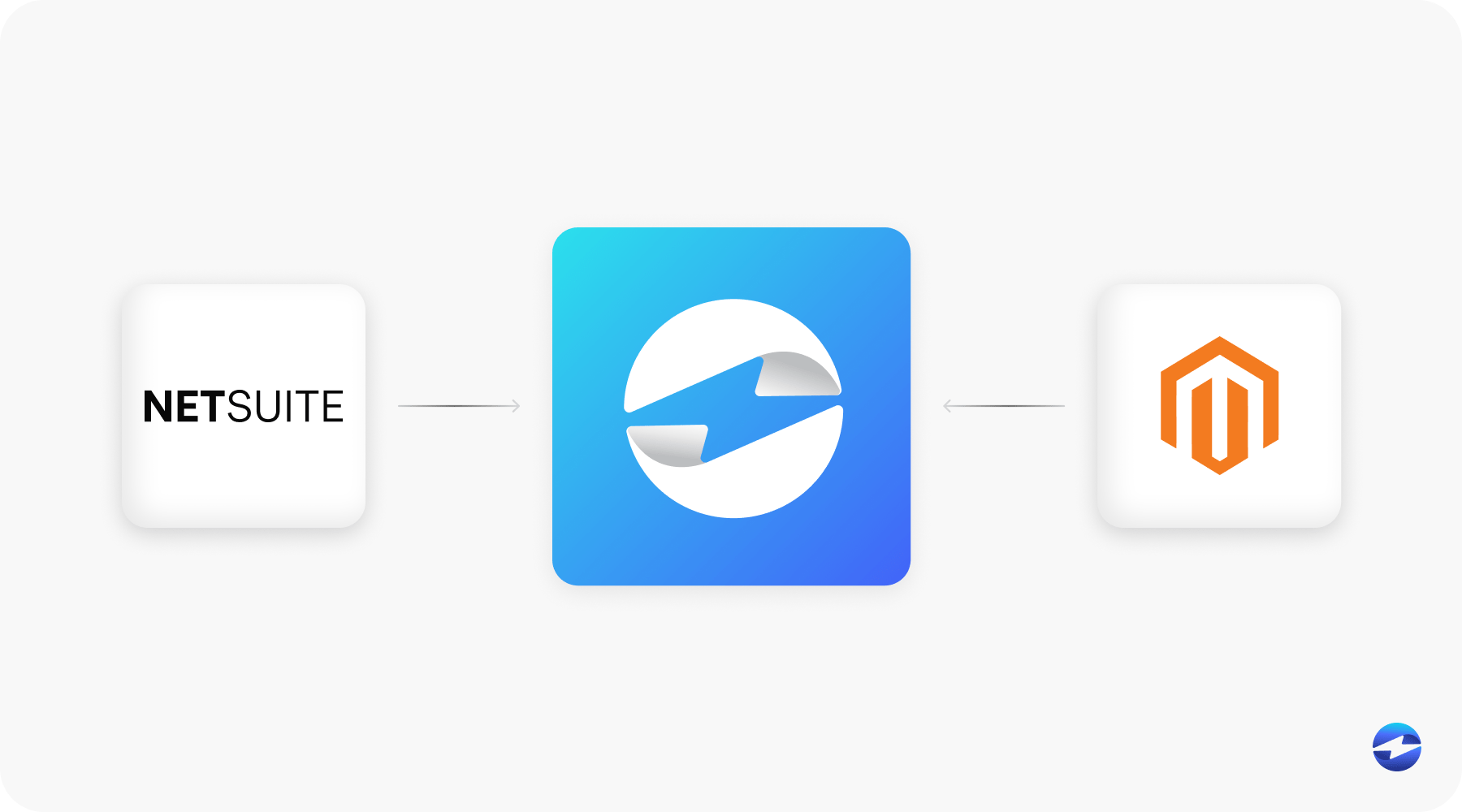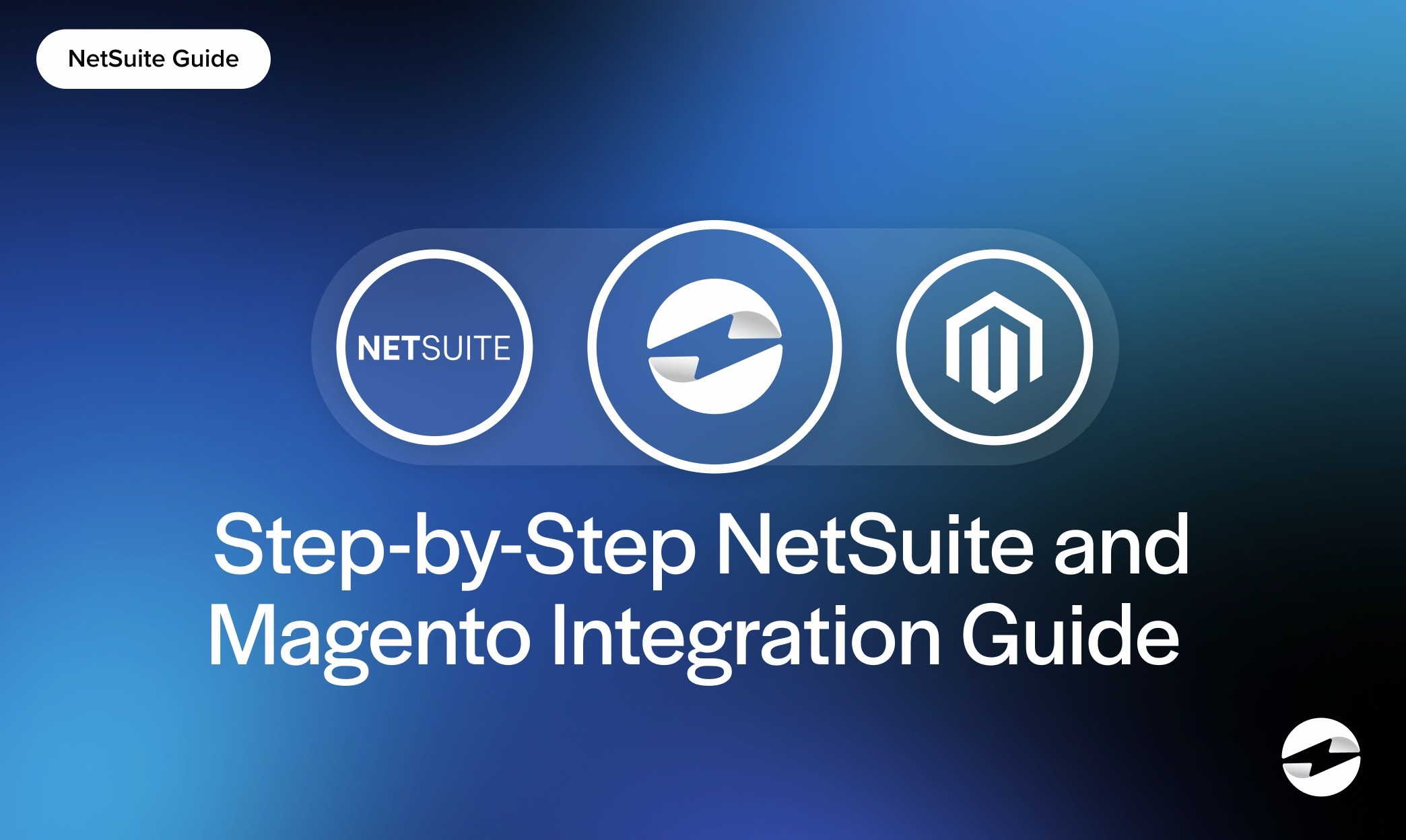Blog > Step-by-Step NetSuite and Magento Integration Guide
Step-by-Step NetSuite and Magento Integration Guide
B2B businesses today are increasingly pressured to build seamless customer experiences while also driving operating effectiveness. Maybe the most effective way to reconcile this conflict is by strategic system integration, namely connecting your eCommerce platform to your enterprise resource planning (ERP) system. Magento and NetSuite integration is an appealing pair that can potentially drive B2B growth by simplifying core business processes and dissolving data silos.
How NetSuite-Magento Integration Fuels B2B Growth
Integrated eCommerce and ERP activities bring much more than just data synchronization advantages. When NetSuite works together with platforms like WooCommerce, BigCommerce, and Magento, companies achieve transformative increases in customer satisfaction, operational efficiency, and revenue growth.
Revenue Growth through Richer Customer Experience
Integrated systems offer real-time visibility of inventory, accurate pricing, and instant processing of orders. Customers can experience this real-time product availability, receive accurate delivery schedules, and trace orders quickly without variations or delays. This transparency builds trust, encourages repeat shopping, and benefits your bottom line.
Operational Efficiency and Cost Reduction
By avoiding the necessity of manually entering data between systems, organizations save labor costs and avoid the possibility of human error. Automated business functions ensure orders are moved seamlessly from your Magento store into NetSuite for fulfilling, processing, and invoicing. This streamlined process allows groups to focus on business efforts rather than paper pushers.
Pre-Integration Assessment and Planning
Prior to entering the technical implementation, effective integration demands careful planning and review of your existing systems and business needs.
System Audit and Requirements Gathering
Begin with a rigorous review of both your NetSuite setup and Magento 2 installation. Note down your existing workflows, customizations, and third-party extensions that may have an effect on the integration process.

The areas to review are:
- Existing NetSuite modules and customizations being utilized
- Magento 2 version, themes, and extensions installed
- Quality and consistency of available data between systems
- Identify manual processes that are likely automation candidates
Definition of Integration Scope
Clearly define the entities of data which will be synchronized between systems and indicate how frequently and under what circumstances synchronizations will occur. This planning step prevents scope creep and all stakeholders can see the project boundaries.
Major synchronization decisions involve choosing product catalog scope and structure, determining customer data integration levels, identifying order management workflow requirements, and establishing inventory synchronization frequency and thresholds.
Technical Prerequisites
Ensure that both systems have the necessary technical requirements for integration. This includes API capability checking, establishing proper user permissions, and considering any network security elements.
Major technical requirements are:
- NetSuite administrator access and integration user setup
- Magento 2 API credentials and proper module installation
- Network connection and firewall configuration in secure settings
- Adequate server resources for more data processing
Choosing Your Integration Approach
The approach you take will have a significant influence on both implementation time and maintenance expenses going forward.
Native NetSuite SuiteCommerce vs. Third-Party Solutions
NetSuite’s SuiteCommerce boasts a native eCommerce solution without any external integrations needed. That said, most businesses appreciate the flexibility and extensive ecosystem of extensions offered by Magento.
SuiteCommerce has some wonderful advantages like no integration maintenance needs, real-time data synchronization, and simpler licensing. Magento integration, however, offers better design flexibility, access to a large extension market, and reuse of existing Magento expertise.

Popular Integration Platforms and Connectors
There are various middleware products that provide NetSuite-Magento integration capabilities, each with unique strengths and limitations. Research platforms like Celigo, Boomi, or Jitterbit that offer pre-existing connectors specifically designed for this integration.
When comparing integration platforms, consider:
- Real-time versus batch synchronization features
- Error handling and data validation options
- Scalability for future business growth
- Support quality and documentation availability
Step-by-Step Setup Process
Successful integration requires close monitoring of configuration details in both platforms as well as the integration platform chosen.

NetSuite Configuration
Begin by establishing the groundwork in NetSuite to communicate with external systems. This includes establishing special integration users, web services setup, and preparing custom fields as required.
Key NetSuite setup steps are:
- Establishing integration-specific user roles with proper permissions
- Activating web services and establishing RESTlet endpoints
- Custom field setup for Magento-specific data requirements
- Establishment of subsidiaries and locations for multi-entity organizations
Magento 2 Setup
Install your Magento 2 setup to communicate effectively with NetSuite by installing required modules and configuring API access.
A few of the most important setup steps involve installing and configuring integration modules, establishing API credentials and authentication, mapping product attributes to NetSuite field formats, and establishing category hierarchies for synchronization.
Integration Platform Setup
Regardless of whether a middleware offering or custom development is utilized, the integration platform must be properly configured to provide a reliable exchange of data between systems.
Critical configuration components are:
- Testing of connections and verification of authentication
- Data mapping rules and transformation logic
- Error handling protocols and notification structures
- Scheduling for batch processing and real-time triggers
Data Mapping and Synchronization Configuration
Your success is highly reliant on precise data mapping and sound synchronization rules.
Product Information Management
Data synchronization of products is the backbone of your integrated system. Establish rigid mapping rules for SKUs, prices, descriptions, and inventory levels.
Key synchronization factors are:
- SKU normalization and mapping processes
- Multi-tier price structures for different groups of customers
- Product category hierarchies and attribute mapping
- Image and media file synchronization processes
Customer Data Integration
Seamless customer data flow creates consistent experiences at every touchpoint while safeguarding data security and privacy requirements.
Critical customer data fields are account setup and profile synchronization, B2B customer hierarchies and approvals, billing and shipping addresses, and credit terms and payment method preference.
The Order Management Workflow
Develop order workflows to process transactions from initial placement through fulfillment and invoicing efficiently.
Order workflow capabilities are:
- Instant order creation on NetSuite during Magento checkout
- Stock confirmation and allocation
- Shipping carrier integration and shipping type selection
- Update of order status and notification to customers
Payment Processing Integration Setup
B2B buyers in the present expect seamless payment experiences nicely integrated with their buying processes. Embedded payments as part of your integrated NetSuite-Magento setup can improve cash flow and reduce administrative hassles.
Configuring Embedded Payment Solutions
Embedded payment processing eliminates the hassle of having customers click through a series of systems or portals to pay. By integrating payment functionality into your existing workflow, you offer a seamless experience that encourages accelerated payment cycles.
Embedded payment key features include:
- Automatic invoice generation during the completion of orders
- Multi-payment method support including ACH, credit cards, and digital wallets
- Support for recurring payments for subscription services
- Automatic retry payment logic for failed transactions
Multi-Currency and International Considerations
When organizations have international presence, payment integration must support varied currencies and international compliance requirements without affecting seamless user experience.
Testing and Validation
Thorough testing ensures your integration performs well under various scenarios and volumes of data.
Integration Testing Protocol
Develop robust test protocols encompassing normal cases, edge cases, and error cases.
Phases of testing should include:
- Unit testing of every data synchronization process
- End-to-end transaction testing from order to order fulfillment
- Load and peak load performance testing
- Error case testing and recovery process test
Data Validation and Quality Assurance
Implement systematic methods to verify data accuracy and consistency across systems.
Validation checkpoints are product data accuracy and completeness, customer data integrity and compliance with privacy, order data consistency and financial reconciliation, and inventory level synchronization and discrepancy resolution.
Go-Live and Monitoring
Installation to your integrated system requires meticulous planning and ongoing monitoring to deliver best performance.
Deployment Strategy
Choose a deployment method with least business disruption while allowing the possibility of quickly resolving issues if problems arise.
Deployment options are:
- Phased implementation by product type or segment
- Parallel operation with phased migration
- Full cutover with strong backup processes
- Geographic implementation for multi-site companies
Routine Monitoring and Maintenance
Engage monitoring processes that proactively identify and correct problems before they impact business operations.
Fundamentals of monitoring include real-time synchronization status notifications, data quality monitoring and reporting of exceptions, monitoring and tuning of performance metrics, and periodic confirmation of backups and disaster recovery testing.
Troubleshooting Common Issues
Knowing common integration issues guarantees that teams will respond quickly when issues arise.
Synchronization Failure with Data
Employ robust error handling and recovery mechanisms when synchronization operations fail. Common failure scenarios are:
- Connectivity loss in the network
- Throttling and rate limiting of the API
- Data validation and format inconsistency errors
- System maintenance windows and downtime
Performance Tuning
Instrument and performance-tune integration performance to guarantee responsive user interfaces as data volumes grow.
Optimization methods comprise query optimization and database indexing, caching for repeat data, batch optimization of massive data, and scaling and allocation processes.
Integration Success Measurement
Establish critical performance metrics that demonstrate the business value of your integration investment.
Operational Efficiency Metrics
Track operational efficiency improvements to quantify the effect of the integration on your business processes.
Critical efficiency metrics are:
- Order handling time decrease percentages
- Labor hours saved from manual data entry removal
- Error rate reductions in order fulfillment
- Customer service inquiry volume changes
Financial Impact Analysis
Measure the return on investment by sizing both cost savings and revenue improvements through integration.
Financial metrics to measure include decreases in labor cost due to automation, revenue increases due to improved customer experience, decreases in errors and chargebacks reduced, and quicker payment collection with improved cash flow.
Conclusion: Maximizing Your Integration Investment
NetSuite and Magento integration is more than a technology initiative—it’s a strategic initiative that positions your business for long-term expansion in an increasingly competitive B2B environment. By converging your eCommerce and ERP into one system, you create a foundation for operational excellence that expands with your business.
The benefits extend beyond near-term efficiency gains to include deeper customer experiences, more effective decision-making through aggregated data, and the responsiveness to act quickly to changing marketplace circumstances. When paired with integrated payment products, such a seamless strategy creates a competitive advantage that drives business growth and customer satisfaction.
Achievement hinges on careful planning, thorough testing, and ongoing optimization. But firms that invest in the right setup and maintenance of integration always see their operation efficiency, customer satisfaction, and bottom-line performance skyrocket. Integrated systems provide the agility and smarts needed to thrive in a more digital economy as B2B commerce continues to grow.

